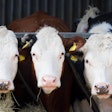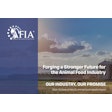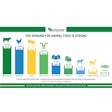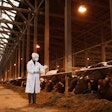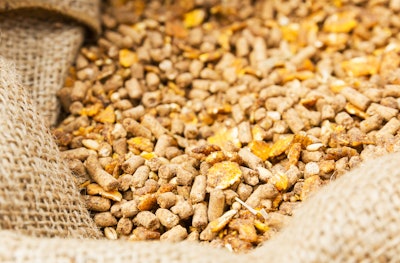
Global animal feed production remained steady in 2023 at 1.29 billion metric tons (BMT), but was down slightly, 2.6 million metric tons (MMT) — or 0.2% — from 2022’s estimates, according to the 2024 Agri-Food Outlook, released April 2 by Alltech. The annual survey, now in its 13th year, includes data from 142 countries and more than 27,000 feed mills.
Alltech said the overall lower demand for feed was due, in part, to the more efficient use of feed made possible by intensive production systems that focus on using animal nutrition, farm management and other technologies to lower feed intake while producing the same amount of protein, or more. A slowdown in the overall production of animal protein, in response to tight margins experienced by many feed and animal protein companies, also contributed to lower feed demand. Changing consumption patterns caused by inflation and dietary trends, higher production costs and geopolitical tensions also influenced feed production in 2023.
Top 10 countries
Together, the top 10 countries produced 63.1% of the world’s feed production (same as in 2022), and almost half of the world’s global feed production is concentrated in four countries: China, the U.S., Brazil and India.
The top 10 feed-producing countries are
- China (262.71 MMT, +0.76%)
- U.S. (238.09 MMT, ‑1.13%)
- Brazil (83.32 MMT, +1.84%)
- India (52.83 MMT, +13.43%)
- Mexico (40.42 MMT, +0.02%)
- Russia (35.46 MMT, +3.83%)
- Spain (27.53 MMT, -11.88%)
- Vietnam (24.15 MMT, -9.63%)
- Japan (23.94 MMT, -1.15%)
- Turkey (23.37 MMT, -11.48%)
Poultry feed
Poultry experienced an increase in broiler feed production (385.04 MMT, +13.10 MMT, +3.5%) and remained steady with a slight increase for layers (170.88 MMT, +0.01 MMT, 0%).
Broiler feed now accounts for 29.9% of the total feed tonnage in the world thanks to a 3.5% increase in overall tonnage in 2023. While this growth was not uniform across all regions, the poultry sector is poised to keep holding strong in 2024 thanks to a combination of regional successes and global market dynamics. Some of the biggest factors that will contribute to the resilience of the broiler sector include reduced costs for inputs, such as feed and energy, and increases in margins and profitability.
For layers, there are industrywide efforts to optimize feed efficiency and to keep pace with changing dietary trends and new purchasing power. Some markets around the globe were significantly impacted by macroeconomic challenges and disease outbreaks, which can disrupt production cycles. Still, the general outlook for the layer industry remains positive thanks to its resilience in the face of difficult circumstances, when other protein sectors often struggle to adapt.
The poultry sector is poised for continued strength, driven by a blend of regional successes and global market dynamics. The broiler forecast remains optimistic thanks to lower input costs, increased industrial margins and shifting consumer behaviors. For layers, challenges persist, but there are pockets of resilience and growth.
Pig feed
The global pig feed production sector faced many challenges in 2023, which led to an overall decrease in pig feed production of 1.23% (320.80 MMT, -4.01 MMT).
Latin America stood out as the only region that achieved an increase in pig feed production in 2023, while Europe, Asia-Pacific and North America — which have traditionally been the top pig feed-producing regions in the world — all faced challenges. African swine fever (ASF) continues to wreak havoc on pig production in China and Southeast Asia, where repopulation efforts are slowly proceeding.
The trends highlight the complex relationship between economic factors, supply dynamics and disease management in the global pig feed industry. Addressing these challenges will be crucial for sustaining animal agriculture and ensuring food security.
Dairy feed
Dairy feed tonnage decreased by 2.3% (126.23 MMT, -2.28%), primarily due to the high cost of feed combined with low milk prices, which led farmers to make strategic adjustments that included reducing their cow numbers and/or relying more on non-commercial feed sources.
In Europe, dairy producers will continue to grapple with stricter environmental policies in the years ahead, and they will need to find new ways to continue growing.
Asia-Pacific managed to buck the downward trend and emerged as the only region that increased its dairy feed tonnage in 2023. This growth was fueled by a continued increase in the consumption of milk products there, as well as an expansion of feed production in cooperatives.
This shift reflects the delicate balance between economic factors and the need to sustain dairy production. Lower feed costs and higher milk prices would help right the ship.
Beef feed
Beef feed production decreased by 4.36% (117.49 MMT, -5.35 MMT) globally — the most pronounced downward change among all species sectors last year. Changes in cattle cycles in the United States and stricter sustainability policies in Europe had major impacts, with the Asia-Pacific beef sector notably surpassing Europe’s in 2023.
Aquaculture
The aquaculture sector experienced a decline of 4.4% (52.09 MMT, -2.42 MMT).
This decline was driven in part by a significant drop in China’s supply of aqua feed due to lower fish prices, which had a far-reaching impact.
Latin America grew by 0.27 MMT (3.87%). Despite adverse weather conditions in that region, the demand for aqua products is still strong in Latin America, which helped aqua producers there remain resilient.
Notable regional results
North America saw a decrease of 2.8 MMT (259.26 MMT, -1.1%), with beef feed tonnage down significantly. The pig and dairy sectors also slipped slightly, but the broiler, layer and pet sectors more than made up the difference. Feed tonnage in the broiler sector was up nearly 2.9%.
Latin America experienced growth in 2023 by 2.46 MMT (200.67 MMT, +1.24%). Despite high production costs, geopolitical tensions and changing consumer behavior due to economic reasons, the region continues to lead global growth, mainly because of its export-driven aquaculture, poultry and pork markets.
Europe continued its downward trend in feed production, with a decrease of 10.07 MMT (253.19 MMT, -3.82%) due to issues that included the invasion in Ukraine and the spread of animal diseases such as African swine fever (ASF) and avian influenza (AI).
Asia-Pacific led feed production growth in 2023, with an increase of 6.54 MMT (475.33 MMT, +1.4%). Feed production growth in the region’s ruminant sectors offset a setback in the aqua sector. The region is home to several of the top 10 feed-producing countries, including China, India, Vietnam and Japan.
Africa experienced continued but slower growth with an increase of 1.95%, nearly 1 MMT to total 51.42 MMT.
The Middle East saw a slight decrease of 0.12 MMT (35.93 MMT, -0.32%).
Oceania had the third-highest growth, 3.71% or 0.39 MMT to total 10.78 MMT.









